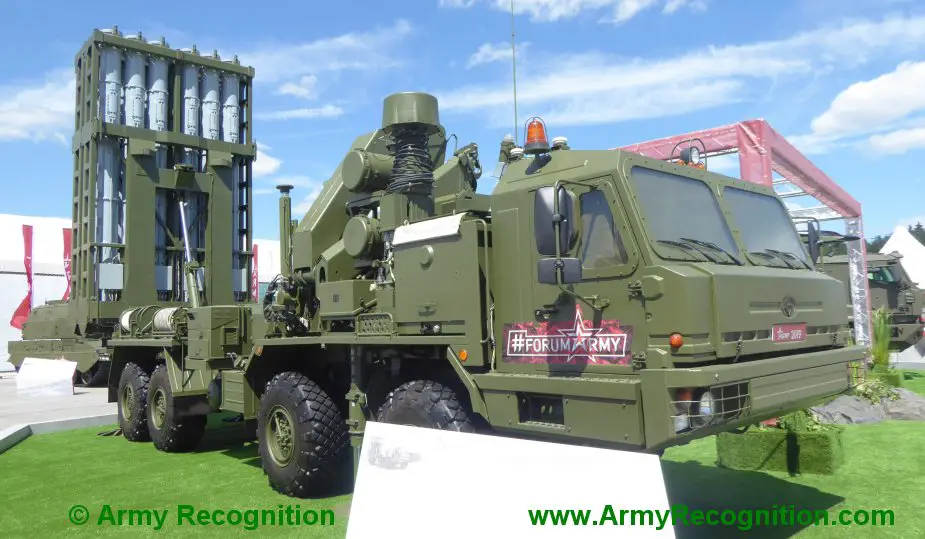Russia: Vityaz S-350 missiles create multilayered air defense
The Russian Aerospace Forces received the first Vityaz S-350 air defense systems. In the coming seven years, the Russian armed forces will receive 12 battalions of 144 launchers. Foreign experts dubbed S-350 as cruise missile killers, the Zvezda weekly writes.

S-350 Vityaz displayed at Army 2019 near Kubinka (Picture source: Army Recognition)
The new weapons are due to South Korea. On the threshold of the 20th – 21st centuries, Almaz Design Bureau (now Almaz-Antey) won the tender to design the prospective Korean medium-range KM-SAM missile. The order was fulfilled by the mid-2000s. The bureau invited the Russian Defense Ministry leadership to see the weapon before shipment to Korea. It ordered a medium-range missile for Russia with another concept and improved characteristics.
The Russian army badly needed such a weapon. In 2015, over 50 S-300PS had to be scrapped after their life cycle expired. There was no replacement and the Korean prototype was chosen. S-350 design began in 2007. Design documentation was ready in 2011 and a prototype produced next year. But the project stalled after a missile exploded in the air during trials at the Kapustin Yar range.
Acceptance trials were completed only in 2019. Almaz-Antey handed over the first Vityaz S-350 set to the Russian Defense Ministry in the end of the year. It was delivered to the Aerospace Forces the other day and arrived in the training center of the Aerospace Defense Academy in the Saint-Petersburg region to become a training simulator.
At various drills, S-400 launchers usually advance to the firing positions together with Pantsir antiaircraft missile guns. S-400 can intercept and destroy targets at a distance of 400 km. However, its effectiveness decreases at medium and shorter distances. 50 kilometers mean point-blank fire for it. A small and low-flying object is a difficult target for S-400. Besides, it is costly to down such targets with S-400.
The Pantsir air defense system, with a range of 20 km, has to intercept such targets. It is the last resort. It would be appropriate to defend S-400 at a distance of 50-100 km. It was the job assigned to the S-300. The S-350 Vityaz will now fill in the gap: "The S-350 has to defend important facilities," expert Viktor Murakhovsky said. "It is deployed in a specific territory and included in on-duty air defense. Its range is close to 120 km and the hit altitude is 30 km. It means a medium range. The army operates another medium-range air defense weapon: the Buk-M2/M3. But its range is 70 km. The Aerospace Forces need 120 km. The Vityaz fits the best," he said.
A multilayered defense means that, initially, long-range weapons have to shoot down a ballistic and cruise missile or an aircraft. If they fail, short-range weapons are engaged. Radars and launchers are united into a single system and pass the target from one tier to another to guarantee interception and destruction. A multilayered defense should have no gaps. The Vityaz-350 will eliminate them.
The S-350 Vityaz comprises self-propelled launchers, a multirole radar and command post on a wheeled undercarriage. The stock of munitions comprises 12 missiles. They can be short, medium and long-range, depending on the mission: a launcher can carry various missiles. It is uselessly expensive to fire the same missile to destroy a fighter jet and at a small drone. So, the onboard computer locks on a target and determines which missile is the most effective.
Another advantage is the ability to repel a massive air raid. The stock of munitions of a battalion is at least 144 missiles. "A major advantage of the S-350 is the ability to simultaneously track 100 targets," Murakhovsky said. "It can fire at several dozen targets at a time. It automatically determines priority targets, the order of fire, etc. It is a weapon with artificial intelligence elements. The computer determines target parameters and automatically sets the sequence of their destruction. It decides which units and launchers should fire for the highest effectiveness. The process is nearly fully automatic. The commander is offered a set of decisions. He can then confirm the choice or select another decision. The response time has decreased and combat effectiveness increased," he said.
Another advantage is the possibility to down small targets at very low altitudes like five meters above the ground. "The weapon can fight drones, like the Pantsir and Tor-M2. The cost of an antiaircraft missile is much higher than the price of a drone. The adversary can first send small drones for Vityaz to exhaust its munitions and precision arms will follow. An example is offered by Israeli strikes in Syria: the Syrian air defense repelled drones, but let guided munitions through," Murakhovsky said.
The Vityaz can fight ballistic and cruise missiles: "Tomahawk or SCALP fly at 40-50 meters above ground level. The Vityaz can operate at an altitude of 5 meters and successfully hit such missiles. The radar is capable of timely detecting them," Murakhovsky said.
Experts say the S-350 will display maximum effectiveness together with prospective S-500 which is to be supplied to the troops in 2-3 years. The S-500 will be able to destroy targets at a distance of 600 km. By combining S-500, S-350, Pantsir and other air defense weapons into a single network, Russia will be able to protect important facilities with multilayered air defense, the Zvezda said.
© Copyright 2020 TASS / Army Recognition Group SPRL. All rights reserved. This material may not be published, broadcast, rewritten or redistributed.


























